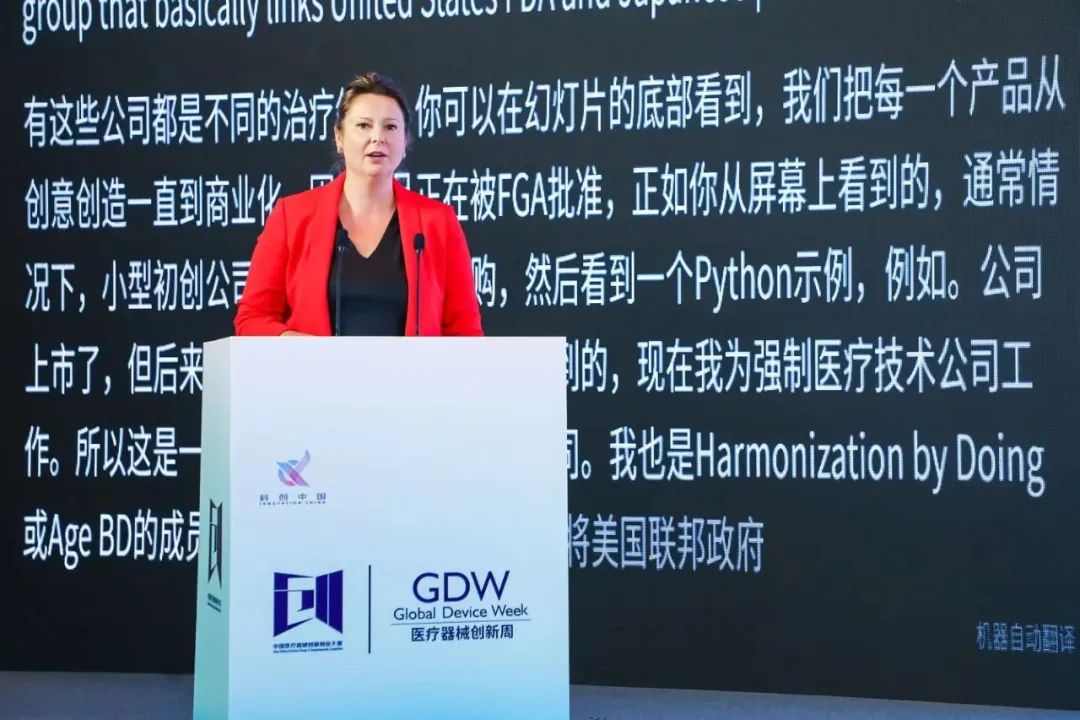The 6th Innovation Week attracted a lot of overseas and overseas experience guests to the scene to share the recent international trends and overseas related policies. The organisers held a seminar on the practical operation and platform construction of medical devices going overseas, in which the guests introduced the current situation of access to overseas medical devices in the US, UK, Australia, Japan and other countries, as well as the preferential policies of each country for the entry of medical devices from China to share their views.
Dr. Kathrine Kumar, a senior FDA regulatory expert from the U.S., explained how to successfully enter the U.S. market in terms of FDA regulations and the latest trends. Dr. Kumar mentioned that the latest update of the FDA’s guideline states that applicants can rely solely on foreign clinical data when submitting an application.
Chinese manufacturers can use Chinese data to apply for US FDA approval, but must allow the FDA access to your trial data sources in China. The U.S. GCP (Good Clinical Practice for Medical Devices) China’s GCP is different, but a large portion of it overlaps. If a Chinese manufacturer is headquartered in China and conducts studies in China, the FDA does not regulate its studies and the manufacturer is only required to comply with local Chinese laws and regulations. If the Chinese manufacturer intends to use the data in the U.S. to support a device or application, it will need to fill in the missing pieces according to U.S. GCP requirements.
If a manufacturer has unforeseen circumstances that prevent them from complying with local requirements, they can apply for a waiver to request a meeting with the FDA. A description of the device and a plan will need to be written and submitted to the FDA prior to the meeting, and the FDA will respond in writing at a later date. The meeting, whether you choose to meet in person or by teleconference, is documented and there is no charge for the meeting.
Referring to preclinical research considerations, Dr Brad Hubbard, co-founder of EastPoint (Hangzhou) Medical Technology Co., Ltd, said: “Preclinical animal testing is a predictive model that allows us to see how animal tissues will respond to a product’s design when a medical device is being studied in animal testing to understand how it functions, and to anticipate how the device will work when it is used in humans.
When considering preclinical work studies, there are two recommendations for guidance to refer to: one is a US federal regulation CFR 21 standard, Part 58 Design GLP, which can be referred to if there is a need to understand the GLP study requirements such as animal feeding, how to evaluate test equipment and control equipment, and so on. There are also draft guidelines from the US Food and Drug Administration and the FDA website that will have specific instructions for preclinical studies, such as how many pigs are needed for animal testing for aortic mitral valve clot removal surgery studies.
When it comes to providing detailed reports for FDA approval, Chinese medical device companies get more attention and questions, and the FDA often sees poor quality assurance, missing animal care information, incomplete raw data, and incomplete lab personnel lists. These elements must be reflected in the detailed report for approval.
Raj Maan, Commercial Consul of the British Consulate General in Chongqing, explained the advantages of the UK’s healthcare and analysed the UK’s friendly policies towards medical device companies by citing examples of companies such as Myriad Medical and Shengxiang Biological that have sailed to the UK.
As Europe’s number one for life sciences investment, UK life sciences innovators have won more than 80 Nobel Prizes, second only to the US.
The UK is also a clinical trials powerhouse, ranking number one in Europe for early-stage clinical trials, with 20 clinical trials worth £2.7bn carried out each year, accounting for 20 per cent of all EU applications.
Continued leadership in new technologies, coupled with an entrepreneurial culture, has fuelled the birth of a number of unicorn start-ups in the UK worth over $1bn.
The UK has a population of 67 million, of which around 20 per cent are ethnic minorities, providing a diverse population for conducting clinical trials.
R&D Expenditure Tax Credit (RDEC): the tax credit rate for R&D expenditure has been permanently increased to 20 per cent, meaning the UK offers the highest uncapped rate of tax relief for large companies in the G7.
Small and Medium Enterprise (SME) R&D tax relief: allows companies to deduct an additional 86 per cent of their qualifying costs from their annual profits, as well as the normal 100 per cent deduction, totalling 186 per cent.
Post time: Oct-11-2023



